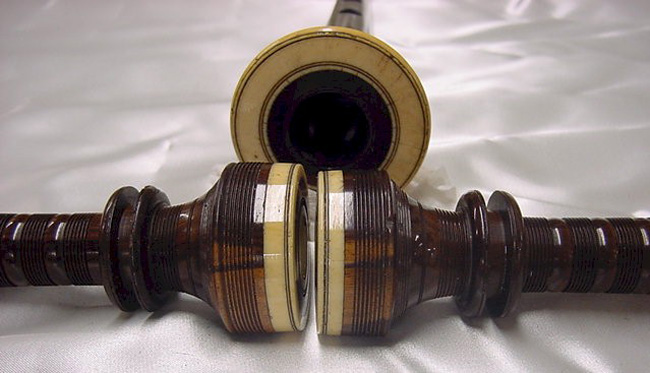Enjoying the pleasures of pipes past
indigenous Scottish woods such as laburnum or fruit wood, and mounts were often bone or horn. As the craft and industry of making bagpipes was still in its infancy and relatively unsophisticated, it is rare to find a maker’s name stamped on an instrument from this era.
Two of the great early makers were Hugh Robertson (c. 1730-1822) and Donald MacDonald (c. 1767-1840), and while there are known sets of MacDonalds that are being played today, there are no Hugh Robertson sets on active duty, but for a set or two of his pastoral pipes. Robertson is often credited with the basic combed/beaded style of modern pipes used to this day, while MacDonald (also a legendary compiler of pipe music) can be said to have perfected the style, making pipes well into the 1830s. Both were meticulous craftsmen, and modern pipe-makers still marvel at the precision and skill apparent in their instruments, which were made with no electricity and with tools that were primitive by today’s standards.
Early woods

Caribbean cocuswood was used as early as the mid-1700s, but during the early 1800s, instrument makers began to acquire exotic hardwoods such as ebony from Africa. Both woods were used extensively until the 1930s, and both were usually thought to be tonally superior to African blackwood, which only came into vogue around the turn of the 20th century. Ebony is a volatile wood to work with: prone to cracking, even as it sits in storage. Cocuswood, a lovely reddish hue, and regarded by many as the greatest musical wood, became increasingly expensive and difficult to acquire after the 1920s. It is now nearly impossible to find instrument-grade cocuswood. African blackwood quickly became the wood of choice among pipe-makers because of its price, availability, good tonal properties and much heartier nature.
A pamphlet produced by James Robertson, a premier maker from 1908 until his death in 1948, describes the materials used in pipemaking. In it, he extols the virtues of blackwood as the greatest pipemaking wood, and you can sense in his writing the frustrations of working with ebony, even though aficionados today would contend that Robertson’s greatest . . .

I’m surprised there are not a number of comments or questions on this article – a lot of information, experience and work in the article, much of which was new to me. So glad the article was retrieved!